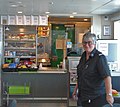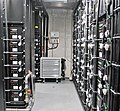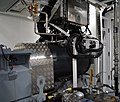Ellen (E-ferry)
 in August 2019
| |
| History | |
|---|---|
| Denmark | |
| Name | Ellen |
| Operator | Ærø Municipality (Ærø Kommune) |
| Port of registry | Søby |
| Route | Søby - Fynshav, Søby - Faaborg |
| Builder | Ridson in Szczecin, Poland |
| Cost | EUR 21.3 million |
| Christened | 1 June 2019 |
| Maiden voyage | August 2019 |
| Identification |
|
| Status | in service |
| General characteristics | |
| Class and type | Electric Ro-Ro Passenger ferry |
| Tonnage | Gross tonnage: 996 GT |
| Length | 59.4 m (195 ft) |
| Beam | 13.4 m (44 ft 0 in) |
| Decks | 4 (superstructure) |
| Installed power | 4.3 MWh battery system (Li-NMC) |
| Propulsion | 2x 750kW propulsion motors and 2x 250kW thruster motors by Danfoss Editron |
| Speed | 12.1 knots (13.9 mph; 22.4 km/h) |
| Capacity | 198 passengers, 31 cars[1] |
| Crew | 3 |
| Notes | [2] |
E-ferry Ellen (Danish: Elfærgen Ellen) is a pioneering electric car ferry. She operates the 22-nautical-mile (41 km) route between the islands of Ærø and Als in Southern Denmark.
History
[edit]Ellen was developed from E-Ferry,[3] an EU-backed project costing EUR 21.3 million. Although this is around 40% more expensive than a conventional vessel, operating costs are 75% lower.[4] It is expected that she will save the release of 2,000 tonnes of CO2 per year.[5]
The ferry was built by Søby Værft A/S,[6] with sections fabricated in Szczecin, Poland.[7][8] In September 2016, 22 sections were welded together and the hull was towed to Søby on Ærø for outfitting.[7]
Project evaluation
[edit]The E-ferry project ended successfully in June 2020, with Ellen in service. Evaluation of the project shows[9]
- 85% energy efficiency (grid-to-propeller)
- 1600 kWh consumption (per roundtrip of 22 nautical miles; approx. 40 km)
- 4–8 years before higher investment cost turns into savings from lower operational costs
- 2,520 tonnes/year CO2 emissions saved (compared to a modern diesel ferry; using electricity produced on Ærøby from clean renewable sources; 2,010 tonnes if powered from the standard Danish grid mix)
- CO2 emissions from battery production estimated 215-430 tonnes (three months emissions from the best modern diesel ferry)
Layout
[edit]Ellen can carry 30 vehicles and 200 passengers. She was designed to minimise weight. Her passenger areas are on the same level as the open car deck.[10] She has no ramps, instead using those on shore. The hull is steel but the bridge is made of aluminum. Deck furniture is made from recycled paper rather than wood, giving the ferry a total weight of 650 tonnes.[1]
Ellen's batteries were developed by Leclanché of Switzerland and are reported to be Lithium Nickel Manganese Cobalt Oxide.[11] They are split between two battery rooms below deck and have a capacity of 4.3 MWh, larger than any other electric vessel at its time. She is one of the first such vessels to have no emergency generator.[1] A charging arm on the shore ramp moves with the tide and allows battery recharging while loading. Charging time is about 20 minutes.[12]
Service
[edit]Ellen was built to operate the 22 nautical miles between the islands of Ærø and Als in Southern Denmark.[13] She replaced MF Skjoldnæs from 15 August 2019.[14]
Gallery
[edit]-
E-ferry Ellen
-
E-ferry Ellen
-
Café
-
4.3 MWh battery system
-
Electric motor
-
Electric motor
-
Technical control room
References
[edit]- ^ a b c Andrew Tunnicliffe (3 September 2019). "Ellen E-ferry: the world's glimpse of the future of ferries". Ship Technology/Verdict Media Limited. Retrieved 2020-05-09.
- ^ "Ellen". Marine Traffic. Retrieved 2020-05-09.
- ^ "E-ferry final presentation". E-ferry Consortium. Retrieved 2020-05-09.
- ^ Murray, Adrienne (2020-01-14). "Plug-in and sail: Meet the electric ferry pioneers". BBC News. Retrieved 2020-05-08.
- ^ "Meet the world's largest e-ferry". CNNMoney Switzerland. 30 September 2019. Retrieved 2020-05-09.
- ^ "Newbuild #107". Søby Værft. Retrieved 2020-08-21.
- ^ a b "E-Ferry Newsletter #5" (PDF). E-ferry Consortium. December 2017. Retrieved 2020-05-09.
- ^ "Ellen – fully electric ferry, soon to be working on the Baltic Sea". Poland@Sea. 5 August 2019. Retrieved 2020-08-21.
- ^ "The E-Ferry Ellen Information Package" (pdf). E-ferry Consortium. Retrieved 15 January 2023.
- ^ "Electric Ferry Makes Record Voyage in Denmark". Maritime Executive. 2019-08-17. Retrieved 2020-05-09.
- ^ "World's largest electric ferry completes maiden voyage; 4.3MWh Leclanché battery system". Green Car Congress. Retrieved 2020-10-12.
- ^ "Nector Shore Charging System Demo in Denmark".
- ^ Tidey, Alice (8 August 2019). "World's largest all-electric ferry sets sail in Denmark". EuroNews. Retrieved 7 May 2020.
- ^ "Come and join Ellen on her inaugural voyage" (PDF). Ærøfærgerne. 14 August 2019. Retrieved 2020-05-09.
External links
[edit] Media related to IMO 9805374 at Wikimedia Commons
Media related to IMO 9805374 at Wikimedia Commons







